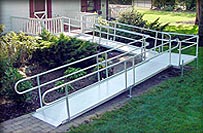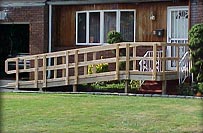Ramp Types

Aluminum Ramps
Aluminum ramps have a more austere look than wood, but their relatively light weight and strength-to-weight ratio can make them ideal for your location. Aluminum ramps lend themselves to modular design where the pieces are manufactured off-site and assembled very quickly at the final installation site. Aluminum ramps are particularly easy to install, remove, re-arrange and reconfigure if they are built with a modular design.
Some advantages for aluminum ramps:
- Light-weight
- Naturally weather resistant
- High Strength
- Multiple surface options
- Easy to Clean
- Modular design available

Wood Ramps
Wood ramps are typically made from pine, and are very easy to customize for the needs of a specific location. Like aluminum ramps, wood ramps are also available in modular designs to allow ease of installation, removal, and reconfiguration. Wood ramps require more maintenance than aluminum ramps, and they tend to be heavier, but for some installations, wood can be more attractive and aesthetic.
- Supplies readily available
- High Strength
- Better aesthetics for some locations
- Modular design available

Portable Ramps
Portable ramps are designed to be taken with when you travel to allow access in areas where no existing ramps are available. Portable ramps can assist with access to short stairways, curbs, raised entrance ways and any other area where an area with a modest rise needs to be accessed. Aluminum is the material of choice for portable ramps, for its light weight and high strength.
For maximum portability, these ramps typically feature hinges that allow them to collapse into a compact travel size, and ergonomically designed handles to facilitate carrying. Look for treads or other non-slip pads for traction. A portable ramp should unfold simply and position easily to provide maximum safety and support. Some can be carried like a suitcase when not in use.
Another common portable ramp type is the threshold ramp. Made for standard or sliding door entry and /or exits, these ramps allow access over small ridges wherever they may occur, most commonly thresholds, as the name implies.
Other Ramps
Other ramp materials include rubber, steel, composites and concrete. Each of these materials have benefits, but issues such as maintenance, weight, expense, difficult installation or removal, traction concerns, and repair issues make these choices far less attractive than wood and aluminum and are not recommended.

Permanent vs. Modular Ramps
Traditionally, ramps of all kinds were built as a permanent structure, with designs created specifically for that ramp. Ramps of these types might be made of wood, aluminum, steel or concrete. There are expensive and represent a major and permanent investment in the property. Every permanent ramp requires custom construction and plans.
Although some ramps may require a permanent or otherwise custom solution, for most, a very good alternative to permanent construction of a ramp is a modular design. These ramps have pre-constructed pieces that can be easily installed, and importantly, just as easily removed. Many of the considerations surrounding permanent installations are not nearly as important with a modular design. They are not permanent structures, so they require no permits for footings. A modular design is less likely to require modifications to the property itself, and are often much more easy to maintain. Often a modular ramp can be resold when it is no longer needed. See your local dealer for more details on how a modular ramp, made of either wood or aluminum, can dramatically reduce your costs and headaches associated with ramp installation.
The state of New Jersey* identifies the following as benefits of modular design for ramps:
- Modular design helps to make homes accessible for all ages and abilities
- Can be assembled in 1 to 2 days
- Does not require permanent concrete frost footings
- Can be installed year-round
- Built to be reused and easily removed
- Built Off-site
* Source: State of NJ Department of Human Services

